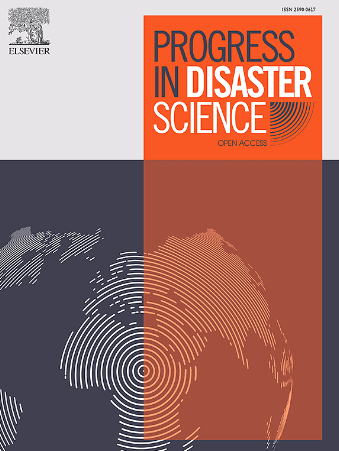Risk identification and prevention of multi-level flood and typhoon prevention emergency drills
IF 3.8
Q3 ENVIRONMENTAL SCIENCES
引用次数: 0
Abstract
Amid increasing extreme weather events driven by global climate change, pre-emptive emergency drills are vital for strengthening disaster resilience. This paper focuses on risk identification and prevention in multi-level flood and typhoon prevention emergency drills, aiming to achieve effective risk management across administrative levels. Through literature review and expert consultation, 24 risk factors were hierarchically identified. A quantitative risk assessment model was developed by integrating the risk matrix and cloud model eigenvalues. The results show that risks are the most serious at municipal-level drills, with 20 risk factors (79.17 % of the total) at Level-III and above, decreasing at lower administrative levels (where risk level are categorized into Level-I (Major), Level-II (Large), Level-III (General), and Level-IV (Low) based on the risk matrix integrating likelihood and consequence levels, and Level-III and above risks may trigger resource wastage, drill failure, or even personnel casualties). Temporally, 39 risk factors at Level-III and above were concentrated in preparation stages across all administrative levels, declining to 3 such risk factors during rectification stage. Spatially, the number of risk factors peaked during the municipal-level and county-level preparation stages (11 risk factors respectively at Level-III and above), with their quantity gradually decreasing as the administrative level decreases and drill stages advance. Based on these findings, a systematic risk prevention matrix is proposed to offer targeted guidance for multi-level flood and typhoon prevention emergency drills in addressing climate change-induced disaster challenges.
多层次防汛防台应急演练风险识别与防范
在全球气候变化导致的极端天气事件日益增多的情况下,先发制人的应急演习对于增强抗灾能力至关重要。本文重点研究了多层次防汛防台应急演练中的风险识别与防范问题,旨在实现跨行政层面的有效风险管理。通过文献回顾和专家咨询,对24个危险因素进行了分级识别。将风险矩阵与云模型特征值相结合,建立了定量的风险评估模型。结果表明,市级以上演习风险最严重,三级及以上有20个风险因素(占总风险因素的79.17%),较低的行政级别(根据可能性和后果等级的风险矩阵,风险等级分为一级(重大)、二级(大)、三级(一般)和四级(低),三级及以上的风险可能导致资源浪费、演习失败甚至人员伤亡)风险降低。从时间上看,各级行政区划三级及以上危险因素在准备阶段集中在39个,在整改阶段集中在3个。从空间上看,风险因子数量在市级和县级准备阶段达到峰值(3级及以上风险因子分别为11个),随着行政级别的降低和演练阶段的推进,风险因子数量逐渐减少。在此基础上,提出了系统的风险防范矩阵,为应对气候变化引发的灾害挑战的多层次防汛防台应急演练提供有针对性的指导。
本文章由计算机程序翻译,如有差异,请以英文原文为准。
求助全文
约1分钟内获得全文
求助全文
来源期刊

Progress in Disaster Science
Social Sciences-Safety Research
CiteScore
14.60
自引率
3.20%
发文量
51
审稿时长
12 weeks
期刊介绍:
Progress in Disaster Science is a Gold Open Access journal focusing on integrating research and policy in disaster research, and publishes original research papers and invited viewpoint articles on disaster risk reduction; response; emergency management and recovery.
A key part of the Journal's Publication output will see key experts invited to assess and comment on the current trends in disaster research, as well as highlight key papers.
 求助内容:
求助内容: 应助结果提醒方式:
应助结果提醒方式:


